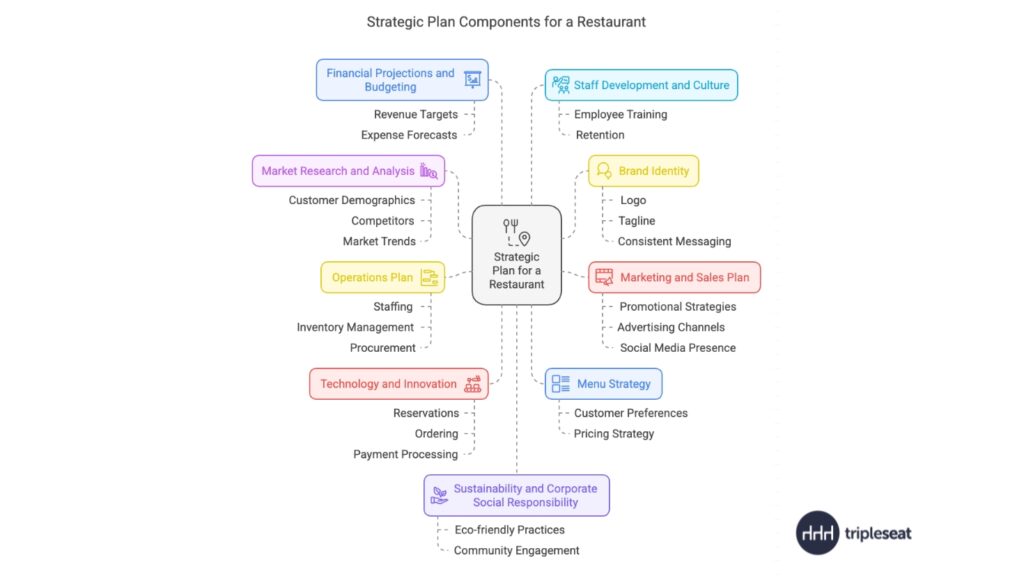Mastering Restaurant Success: Best Practices in Restaurant Strategic Planning

This year’s strategic plan for your restaurant is more important than ever! Running a restaurant is no small feat, from managing food costs to creating unforgettable guest experiences, every decision counts. A well-thought-out plan ensures your restaurant stays competitive, profitable, and ready to tackle whatever challenges come your way. Let’s explore some best practices to help you craft and execute a winning strategy for your restaurant to improve your business and meet your goals.
Why is a Restaurant Strategic Plan Important?
Many restaurant owners and managers may feel they don’t need a strategic plan, believing they have everything under control. While that might be true to some extent, taking a step back to reassess your business can uncover valuable opportunities for improvement. A fresh perspective can help identify ways to streamline workflows, enhance customer experiences, and boost profits. This is where a strategic plan becomes invaluable.
A restaurant strategic plan provides a clear outline for achieving your goals while ensuring your business stays adaptable and competitive. It helps you define your vision and objectives, keeping your focus on what truly matters. By analyzing your target audience, market trends, and operations, a strategic plan gives you the tools to evaluate every aspect of your restaurant thoroughly. It also enables proactive decision-making, helping you address challenges such as rising food costs, staffing issues, or shifting customer preferences.
Beyond improving daily operations, a strategic plan fosters long-term success. It ensures that your restaurant not only runs smoothly but also continues to grow, delivering exceptional experiences that keep customers coming back. With a solid plan in place, you can transform opportunities into actionable results, driving higher profits and sustained success.
What Are the Key Components of a Strategic Plan for Restaurant Business?
Think of your strategic plan for your restaurant business as a comprehensive roadmap to achieve success and sustain growth. It begins with a clear vision and mission statement, outlining the restaurant’s long-term goals and its purpose in delivering value to customers. Supporting this is a set of core values, which guide operations, decision-making, and the overall team culture. Understanding the market is another key component, involving market analysis to define the target audience, assess competitors, and identify industry trends. Complementing this is a SWOT analysis, which evaluates the restaurant’s strengths, weaknesses, opportunities, and threats to determine areas for improvement and growth.
Setting goals and objectives is crucial; these should be specific, measurable, achievable, relevant, and time-bound (SMART) to provide clear benchmarks for success. The menu strategy also plays a pivotal role, focusing on creating a balanced, profitable, and engaging menu that aligns with the brand and customer preferences. Operational efficiency is addressed in the operational plan, which covers staffing, inventory management, and consistent service standards. Financial sustainability is ensured through a financial plan, which includes budgeting, forecasting, and contingency planning for unexpected challenges.
A robust marketing and branding strategy is essential to establish a strong presence, combining digital channels like social media and email marketing with offline efforts like local partnerships and events. Integrating technology further enhances operations and customer experience, with tools such as POS systems, online reservations, customer relationship management (CRM) software, and event management software. A focus on customer experience ensures that exceptional food quality, service, and ambiance create lasting impressions. Finally, an effective plan incorporates monitoring and evaluation mechanisms to track progress, measure success, and adapt to changing circumstances. For restaurants aiming for growth, a growth and expansion plan outlines strategies for scaling, such as introducing new revenue streams, expanding locations, or forming strategic partnerships. Together, these components form a strategic framework to navigate challenges and drive long-term success in the restaurant business.

Steps to Take for Strategic Planning for Restaurants
Here are best practices for a strategic plan for a restaurant business that ensures a clear roadmap for achieving success.
1. Define Your Vision and Goals
Start with the big picture. What do you want your restaurant to be known for? Maybe it’s the go-to spot for farm-to-table dining, a lively place for happy hours, or the most sought-after private event venue in town. Define clear, measurable goals to support this vision, such as increasing annual revenue by 15% or growing your private event bookings by 20%. Objectives should be SMART: Specific, Measurable, Achievable, Relevant, and Time-bound.
Pro Tip: Involve your team in goal-setting to ensure alignment and buy-in. A shared vision fosters enthusiasm and accountability.
2. Determine Your Restaurant’s Core Values
Clarify the purpose of your restaurant and what it delivers to customers daily. (e.g., “To provide delicious, locally-sourced meals in a welcoming environment.”) Highlight the principles and standards that guide your operations, such as sustainability, innovation, exceptional service, or community focus. These values set the tone for your brand and team culture.
Pro Tip: When clarifying your restaurant’s purpose and values, involve your team in the process. Host a brainstorming session where staff can share their perspectives on what makes your restaurant special and what customers value most. This not only helps refine your mission and principles but also fosters buy-in from your team, ensuring your values are reflected consistently in every customer interaction. Keep your mission concise and actionable, and display it prominently for both staff and guests to see—it’s a daily reminder of what your restaurant stands for.
3. Analyze the Market
Conduct thorough market research to understand your target audience and competitors. Are you catering to young professionals, families, or tourists? What are your competitors doing well, and where can you differentiate? Tailoring your offerings to your ideal audience gives you a competitive edge.
Use tools like surveys, online reviews, and point-of-sale data to gather insights into customer preferences and spending habits. Research industry benchmarks for venues similar to yours by exploring hospitality and food service whitepapers, trend reports, and statistical findings. Dive into your competitive set to identify and understand your direct competitors while reviewing this data. By comparing your performance to industry standards, you can clearly see whether you’re exceeding, meeting, or falling short of typical performance levels. This analysis will provide valuable insights to guide your strategic decisions and improvements.
Here are some things to think about when analyzing and benchmarking where your business lies within the market:
- Target Audience: Define your ideal customer based on demographics, dining preferences, and spending habits.
- Competitive Analysis: Understand who your competitors are, what they offer, and how you can differentiate your restaurant to capture market share.
- Industry Trends: Identify food and beverage trends, dining habits, and emerging technologies shaping the restaurant landscape.
4. Conduct a SWOT Analysis
Assess your Strengths, Weaknesses, Opportunities, and Threats to create a realistic view of where your restaurant stands and where it can grow.
Pro Tip: When conducting a SWOT analysis for your restaurant, involve team members from different departments—kitchen staff, servers, and management—to get diverse perspectives. Frontline employees often have unique insights into customer preferences, operational bottlenecks, and potential opportunities. Use their input to create a well-rounded analysis that accurately reflects your restaurant’s strengths, weaknesses, opportunities, and threats. Regularly revisit your SWOT analysis as market conditions, customer expectations, and internal dynamics evolve.
5. Develop Your Menu Strategy
Your menu plan and design is the backbone of your business. Analyze sales data to identify your most profitable dishes and ensure they take center stage. Remove low-performing items that add little value, and don’t shy away from regular updates and pricing to keep your offerings fresh and aligned with customer trends.
Pro Tip: Highlight your signature dishes or seasonal specials with visually appealing menu design to draw attention to high-margin items.
6. Plan to Streamline Your Restaurant Operations
To streamline operations, restaurants can strategically plan by identifying key action items that enhance efficiency and reduce overhead. One important step is to implement a centralized system for managing reservations, including private dining bookings, to ensure smooth coordination between the front and back of the house. Establishing clear communication channels across staff members, whether through digital tools or regular check-ins, helps maintain a seamless workflow. Restaurants can also optimize inventory and supply chain management by analyzing usage patterns and ordering based on data-driven insights. Additionally, having well-defined roles for staff, particularly in managing private dining events, ensures that every detail—such as guest preferences, menu customization, and event logistics—are handled smoothly, leading to a more organized and profitable operation.
Pro Tip: To streamline communication at a restaurant, implement a centralized communication platform that connects all departments, from front-of-house to kitchen staff. Tools like instant messaging apps or specialized restaurant management software can ensure that everyone is on the same page in real-time. For example, using an event management system like Tripleseat for private events can help share important event details (guest count, special requests, timelines) with the entire team instantly. This reduces miscommunication, speeds up service, and enhances the overall guest experience, especially during high-demand times.

7. Conduct a Clear Financial Plan
To conduct a clear financial plan, a restaurant should start by assessing its current financial position, including reviewing income statements, cash flow, and existing liabilities. Set clear goals for both short-term and long-term financial objectives, such as increasing revenue from private events, optimizing food costs, or expanding the menu. Establish a detailed budget that accounts for operating expenses, including payroll, inventory, utilities, and marketing. Factor in anticipated costs for new initiatives like catering services or private dining programs, ensuring adequate resources are allocated to support growth. Regularly track performance against your financial goals and adjust as needed, using tools like accounting software or POS systems to gain real-time insights into profitability. By maintaining a clear and organized financial plan, a restaurant can not only ensure operational stability but also position itself for sustainable growth and success.
Pro Tip: Tne key tip for a restaurant’s financial plan is to establish clear financial benchmarks for each department (e.g., food costs, labor, marketing). By regularly measuring performance against these benchmarks, you can quickly identify areas where you might be overspending or underperforming.
8. Outline a Comprehensive Marketing and Branding Strategy
Begin by clearly defining your brand identity, including your logo, tone, color palette, and design elements, ensuring consistency across all touchpoints.
Next, develop a multifaceted marketing plan that incorporates both digital and offline strategies. Leverage digital channels such as social media, email marketing, and targeted online ads to reach your audience where they are most engaged. Complement this with offline tactics like hosting events, building local partnerships, and offering exclusive promotions to connect with your community.
Finally, incorporate strategies to foster customer loyalty, such as creating a rewards program, offering personalized promotions, or curating exclusive experiences to strengthen customer relationships and drive repeat business.
Pro Tip: Utilize Tripleseat’s lead form into your social media profiles to promote your events and private dining.
9. Leverage Technology Integration
Integrating the right technology is crucial for optimizing restaurant operations and delivering a superior customer experience. Utilize advanced POS systems to ensure seamless, efficient transactions, reducing wait times and enhancing order accuracy. Implement online reservation and ordering platforms to simplify the booking and dining experience, making it easier for guests to engage with your venue. Additionally, use CRM tools to gather valuable guest data and craft personalized communications, from tailored offers to event invitations.
For venues that host private dining or events, consider using event management software like Tripleseat. This tool streamlines event coordination, from booking to payment processing, helping you manage private events more efficiently while capturing valuable customer and operational insights. By optimizing these processes, you can better monetize your events and private dining offerings, ensuring a smoother operation and increased revenue potential.

10. Integrate Customer Experience in Your Restaurant Planning
To create a truly unforgettable experience for your guests, prioritize every aspect of their visit. Begin by delivering exceptional food quality and impeccable service, ensuring that each guest feels valued and well-cared for from start to finish. Actively solicit and act on guest feedback, using it as a tool for continuous improvement and to show guests that their opinions matter.
Pro Tip: Elevate the overall atmosphere by enhancing ambiance through carefully selected decor, lighting, and music that align with your brand and create the right mood for each dining experience. By thoughtfully integrating these elements, you can transform an ordinary visit into an extraordinary one, leaving a lasting impression that encourages repeat visits and positive word-of-mouth.
11. Continue to Monitor Your Restaurant Plan
Consistently monitor and assess progress using data and key metrics. For example, review sales reports and customer feedback regularly. Compare actual performance with your set goals and be prepared to adjust your strategy as new challenges or opportunities arise. Staying flexible ensures you can adapt and stay on track toward your objectives.
Pro Tip: To make tracking progress more efficient, set up automated reports through your POS or other restaurant software. These reports can provide real-time insights into sales trends, customer satisfaction, and goal performance.
12. Plan for Growth and Expansion
Unlock additional revenue potential by diversifying your offerings. Consider adding catering services or expanding your private event capabilities to reach new customer segments and capitalize on demand for special occasions.
Look into expanding to new locations or exploring franchising opportunities to grow your brand and increase market presence.
Strengthen your business ecosystem by building strategic partnerships with local suppliers or neighboring businesses, fostering community connections, and enhancing brand visibility. These initiatives not only create new revenue channels but also help build a more resilient and scalable business model.
Pro Tip: When exploring new revenue streams like catering or private events, consider using event management software like Tripleseat to streamline booking and logistics. This tool can help you track event inquiries, manage guest preferences, and automate follow-ups, making it easier to scale your operations and deliver exceptional service. By efficiently handling the backend of your events, you can focus on growing these new revenue streams without compromising on quality or customer satisfaction.
Rely on Tripleseat to Achieve Your Restaurant’s Event and Private Dining Goals
By defining clear goals, understanding your audience, and leveraging the right tools, you’ll position your restaurant for long-term success. Discover how Tripleseat can streamline your events and private dining operations, elevating them to the next level. Start planning now—schedule a time to connect today!
